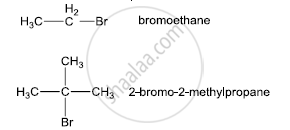Advertisements
Advertisements
Question
Which would undergo SN1 reaction faster in the following pair and why?

Solution 1
Carbocations are the intermediates in the SN1 reaction. Greater the stability of the carbocations, more easily will the product be formed and hence faster will be the rate of the reaction. Because the stability of the carbocations decreases in the order: 3° carbocation > 2° carbocation > 1° carbocation > CH3+.
Therefore, the reactivity of alkyl halides towards SN1 reactions decreases in the same order, i.e. 3° alkyl halides > 2° alkyl halides > 1° alkyl halides > methyl halides.
The two structures are

Bromoethane is a primary alkyl halide which forms a 1° carbocation intermediate in the SN1 reaction. The other compound is 2-bromo-2-methylpropane which is a tertiary alkyl halide which forms a tertiary carbocation intermediate in the SN1 reaction. Hence, 2-bromo-2-methylpropane undergoes an SN1 reaction faster than bromoethane
Solution 2
A tertiary alkyl halide tends to undergo the SN1 mechanism because it can form a tertiary carbocation, which is stabilised by the three alkyl groups attached to it. As alkyl groups are electron donating, they allow the positive charge in the carbocation to be delocalised by the induction effect. Hence, out of the given pairs, (CH3)3C-Br would undergo SN1 reaction faster than CH3-CH2-Br.
APPEARS IN
RELATED QUESTIONS
The treatment of alkyl chlorides with aqueous KOH leads to the formation of alcohols but in the presence of alcoholic KOH, alkenes are major products. Explain.
In the reaction, \[\ce{R - X + NaOR' -> ROR’ + X}\] ( – ve ion). The main product formed is:
Which compound in the following pair reacts faster in SN2 reaction with OH–?
- CH3Br or CH3
- CH3Cl, (CH3)3CCl
Which of the following compounds is optically active?
Which of the following is a chiral compound?
Among the following, the dissociation constant is highest for:
SN1 reaction of alkyl halides lead to ___________.
Elimination reactions (especially β-elimination) are as common as the nucleophilic substitution reaction in case of alkyl halides. Specify the reagents used in both cases.
Arrange the following compounds in increasing order of reactivity towards SN2 reaction.
2-Bromopentane, 1-Bromopentane, 2-Bromo-2-methylbutane
The following questions are case-based questions. Read the passage carefully and answer the questions that follow:
|
Nucleophilic Substitution: Influences of solvent polarity: The reaction rate (SN2) of 2-bromopropane and NaOH in ethanol containing 40% water is twice slower than in absolute ethanol. Hence the level of solvent polarity has an influence on both SN1 and SN2 reactions but with different results. Generally speaking, a weak polar solvent is favourable for SN2 reaction, while a strong polar solvent is favourable for SN1. Generally speaking, the substitution reaction of tertiary haloalkane is based on SN1 mechanism in solvents with a strong polarity (for example ethanol containing water). |
Answer the following questions:
(a) Why racemisation occurs in SN1? (1)
(b) Why is ethanol less polar than water? (1)
(c) Which one of, the following in each pair is more reactive towards SN2 reaction? (2)
(i) CH3 – CH2 – I or CH3CH2 – Cl
(ii)

OR
(c) Arrange the following in the increasing order of their reactivity towards SN1 reactions: (2)
(i) 2-Bromo-2-methylbutane, 1-Bromo-pentane, 2-Bromo-pentane
(ii) 1-Bromo-3-methylbutane, 2-Bromo-2-methylbutane, 2-Bromo-3- methylbutane
